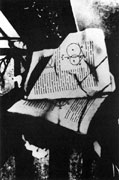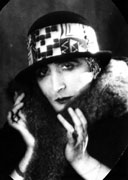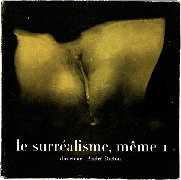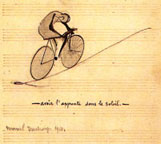What Makes the Bicycle Wheel a Readymade? by
Yassine Ghalem |
||||||||||||||||||||||||||||||
|
Dear Tout-Fait, This question is in my mind and it drives me crazy... Is the Bicycle Wheel a readymade? One of my first contacts with the work of Marcel Duchamp was an interview he gave (in French) in the late 60s. He explained very well what the idea behind a readymade is. He also explained the process that led to the Bicycle Wheel. I remember that he said he used to live in a small apartment in Paris and he wanted to have a fire to warm the place, and also because it would have been nice to have a fire in this small apartment. As he didn't have any "cheminee de coin," he couldn't have any fire. He came up with the Bicycle Wheel on the "tabouret" because moving the wheel reminded him of the movement and sound of a fire. Knowing that, I was a bit confused, as that could mean that the Bicycle Wheel's purpose is to "imitate" a fire. When Miro takes two plates, a rock and a rack and places them together so that they look like a strange personnage, no one says it is a readymade. And I agree. Its purpose is to imitate or give birth to a poetic living form. It is on purpose that this living form looks human in some way (to make it easier for us to understand, maybe). Anyway, I don't see so many differences between Miro and his plates and rocks, and Marcel Duchamp and his Bicycle Wheel (I am only talking about the Bicycle Wheel, I understand why the Bottlerack, for example, is a readymade). I know you might be wondering why I am sending this question to Tout-Fait. Well, you are actually the only person I know who might be able to correct me, and also, it is an opportunity to thank you for the journal. I was very happy to read all of the articles, and really stoned by the news concerning the copies and the 3 Standard Stoppages (!!). Thanks for the help, and I can't wait to read the second edition of Tout-Fait. Yassine
Ghalem
Rhonda Roland Shearer responds:
The Duchamp Bicycle Wheel (1913), and Stool was only referred to by Duchamp but was never seen because Duchamp claimed that it was "lost" and undocumented by any photographs. The 1941 print of his Bicycle Wheel in the Boite en Valise (the first time that we see a visual representation relevant to, but not actually depicting, his 1913 original) was chosen by Duchamp from a series of at least five studio photographs (circa 1916-17) taken of the 2nd version, made in his New York studio. The photograph that Duchamp selected to use for creating his 1941 Boite pochoir print appears to be retouched. (We are in the process of subjecting this image to forensic analysis for further determination of the specific alterations.) Based upon the depicted bicycle wheel and stool shapes, I argue that the movement of the wheel would hardly be relaxing (as in watching a fireplace) but would, in fact, continually wobble out a warning of an eventual crash and fall of the stool. (See my article "Why is the Bicycle Wheel Shaking?")
In addition to the distorted shape of the bicycle wheel and stool in the source photograph for Duchamp's 1941 Boite en Valise print (see Illustration 1), the stool rungs and legs are extremely blurred in ways that contrast with the other, more sharply-focused, surface. One is led to ask — are the legs and rungs askew due to photographic or physical alterations? Duchamp's use of photographic alterations would not be surprising. Scholars readily acknowledge that Duchamp, throughout his career, retouched photographs. Examples include Unhappy Readymade (1919) (where Duchamp adds the appearance of a printed geometric axiom to a photograph of book pages whose typeface had been washed away by rain), the famed Rrose Selavy portraits (1921) by Man Ray (where Duchamp enhances Rrose's hands), and the cover of Surrealism, Même (1956) (where Duchamp retouches a photograph of his concave fig leaf sculpture to enhance the illusion of convexity already, in part, created by special effects lighting). (See illustrations 2, 3, 4)
|
||||||||||||||||||||||||||||||







